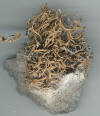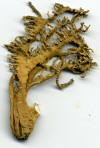|
Niebla and Vermilacinia (Ramalinaceae) from California and Baja
California. |
|
|
|
Niebla usneoides is a fruticose lichen endemic to Baja California and Baja California Sur (Spjut 1996). It was treated as a synonym of N. isidiaescens by Bowler and Marsh (2004) and reported to occur further north in the Channel Islands and mainland southern California (Bowler et al. 1994; Bowler & Marsh 2004); however, the California thalli may prove to be Vermilacinia acicularis, which differs by the terpenoid lichen substances and lack of chondroid strands in the medulla. Niebla usneoides has sekikaic acid with different triterpenes. In Baja California, N. usneoides extends south into the Magdalena Desert Region. Niebla usneoides, which is similar to N. isidiaescens, is distinguished by the lichen substance divaricatic acid (with triterpenes). There may also be a difference in the relative abundance of pycnidia for the two species in that N. isidiaescens frequently has more pycnidia than N. usneoides. More study is needed to assess whether this has taxonomic value. Although Niebla usneoides is similar to N. isidiaescens, it appears related to N. suffnessii, which may be viewed as the other species in a 'species pair' relationship; N. suffnessii usually has apothecia (80%) and pycnidia along cortical ridges on flagelliform to whip-like branchlets. Additional References: See Niebla. |






